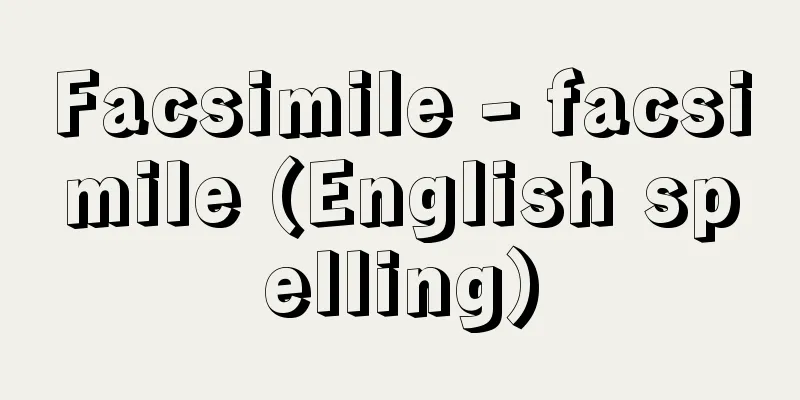Japanese dressmaking - Wasai

|
It is an abbreviation of "wafuku sewing." It is also called "wafuku tailoring." After the Meiji period, Western clothing sewing began to be done, so the words "wasai" and "yosai" came to be used to distinguish it from Western clothing. [Kazuko Okano] Features[1] Japanese dressmaking involves sewing together rectangular pieces of cloth to create a flat structure. [2] Japanese clothing is tailored to a loose fit, not tight to the body, and the three-dimensional shape is shaped by the way it is put on. Therefore, the finished dimensions can be roughly the standard dimensions, except for the length, width, and sleeve length. [3] Children's long kimonos and haori coats can be adjusted at the shoulders and waist as the child grows. [4] Standard width (approximately 36 cm) and wide width (approximately 75 cm) Japanese fabric is cut in straight lines, so no patterns are used and the fabric is cut by folding and laminating. [5] Because Japanese clothing has a fixed shape, attention should be paid to the placement of the pattern when cutting to create a beautiful effect. [6] The stitching is mostly straight lines, except for the rounded sleeves and the collar of the coat, and is hand-sewn. However, sewing machines may be used for simple tailoring of undergarments, kimonos, and yukatas, coats, kimonos made of wool or synthetic fibers, and ready-made products. [7] Unlike Western clothing, Japanese clothing does not change in design, so the cutting and sewing methods are almost the same whether it is for men or women, adults or children, or jackets or underwear. [8] When cutting Japanese clothing, the excess width of the fabric is not cut off, but sewn in, so that by undoing the seams and arranging them, the cloth can be restored to its original rectangular shape before cutting. [9] It can be re-tailored to change the size or replace damaged parts to make it new. It can be washed, stretched, and re-dyed to look like new, and can be economically repurposed into adult clothing for children, kimonos for haori or coats, hanten (shoulder jackets), obi (sashes), and futons. [Kazuko Okano] Types of tailoring(1) Hitoe tailoring: A tailoring method without a lining. For cotton kimonos, shoulder pads and linings are attached to the lining, and the seams are finished with selvedge quilting. For silk and linen, a sheath and back lining are attached, the seams are finished with folded quilting, and the hem is framed. (2) Awase tailoring: A tailoring method with a lining. (3) Cotton-filled tailoring: Cotton is placed between the front and lining. For cold weather, kimonos, haori, hanten, tanzen, and nenneko hanten are made, but this is rarely done these days. (4) Cotton-filled cuffs: Cotton is placed in the cuffs, hem, and hem to make them fluffy, and is now mainly used for formal wear. (5) Musou tailoring: A method of tailoring a kimono in which the front fabric is turned over to the back and sewn with the same fabric. A kimono undergarment with the same fabric used for the lining of the lined sleeves is called a musou-sode. [6] Double-sided tailoring The front and back are sewn together, and the garment can be worn either way. Used for haori and coats. [7] Turn-back tailoring The front and back fabric are turned back from the hem to the back and sewn as a hemline. Used for tomesode and other garments. [8] Toronuki tailoring Used for layered undergarments and nagajuban. A cost-saving method of using good quality fabric for the visible outer parts and a different fabric for the torso. [9] Layered tailoring Used for formal wear, with the upper and undergarments sewn to the same size when worn. [10] Hiyoku tailoring Also called doll tailoring. Used for tomesode and other garments. A tailoring method in which the undergarment fabric is layered and sewn around the collar, cuffs, hem, etc. to make it look like two layers are layered. There are two types: hon-hiyoku and tsuke-hiyoku. [11] Full-length tailoring A tailoring method used for thin gauze single-layer haori. The seam is cut to a width of 8 mm, and the cut edge is folded over to finish. [12] Backing tailoring For tie-dyed fabrics, a thin, starch-free export habutae is applied to the back and the garment is sewn into a single piece of cloth. [13] Mirror tailoring Also called frame tailoring or picture frame tailoring. A tailoring method often used for futons, in which the lining fabric is sewn wide on all four sides. When the back of the Nagoya obi is mirror-tailored and made the same size as the width of the drape, it is called dye tailoring. [14] Tweezers tailoring A tailoring method mainly used for futons, in which the front and back are butted together. [15] Men's tailoring A method of tailoring for men's kimonos. Or it refers to kimonos made by a male seamstress. [Kazuko Okano] Types of cutting[1] Ko-cutting Also called Hitotsu-mi-cutting. A method of cutting kimonos for newborns to around 3 years old. Cut using one third of one roll of fabric. The left and right body parts are made from one standard width, and there is no back seam. [2] Mitsu-mi-cutting For 3-year-olds, cut from 4.5 meters to half a roll of fabric. Four sleeve lengths are taken, and the collar is taken from that width. The body length is three times as long. There are double-sided cutting and single-sided cutting (additional cutting). There is a back seam, and the back width, front width, and collar width are well balanced, but since the body width cannot be made wide, the period of wear is short, and it is not used much nowadays. [3] Chu-cutting Also called Yotsu-mi-cutting. A method of cutting kimonos for children around 3 to 12 years old, using one half or two thirds of a roll of fabric. Four sleeve lengths and body lengths are taken, the collar is cut off from the standard width, and the remainder is used as the back body. The front body and the collar are cut from one continuous piece of fabric. [4] O-cutting This is also called hon-cutting. This is the cutting method for adults. A long kimono is made from one roll of fabric (approximately 11.4 meters). Four pieces are taken for the sleeve length and the length of the body, and two pieces are taken for the collar length. The collar is half the width of the kimono, and the collar and the collar are cut from the remaining half of the width after the collar is removed. [Kazuko Okano] ToolsThe quality and proper use of these tools will affect the quality of the finished kimono and the efficiency of the sewing, so it is important to carefully select them. (1) Sewing needles, quilting pins, and safety pins. (2) Sewing thread. (3) Thread-cutting scissors and dressmaking scissors. (4) Ruler and tape measure. (5) Spatula, chalk, and roulette. (6) Spatula stand. (7) Thimble. (8) Iron and iron. (9) Spray bottle. (10) Iron stand and patch cloth. (11) Rolling pin. (12) Quilting stand. (13) Safety pin. (14) Sleeve rounding mold. (15) Eyelet. (16) Paperweight. (17) Sewing table (cutting board). (18) Cloth hanger. [Kazuko Okano] The order of tailoringDetermine the finished sizeThe shape of a kimono remains constant except for slight local changes due to fashion, so standard measurements will generally suffice, but for parts that need to be tailored to the body shape, measurements are taken to determine the appropriate dimensions for that body type. (1) Measurement points and how to measure [1] Height. [2] Length: Measure from the base of the neck along the front and back of the body to the ankle, and take half that measurement. [3] Sleeve length: Hold your arm horizontally and measure from the center of the back to where your wrist is hidden. [4] Waist: Measure around the widest part. As an exception, if the waist circumference is larger, measure the waist circumference instead. (2) How to calculate the measurements / For women's kimonos with large cut, long kimonos [1] Length Add the length of the hem to the length. It can be the same as the height. For going-out wear or if you want more hem, make the length slightly longer. [2] Sleeve width Increase or decrease the measurement depending on whether the person has broad shoulders or sloping shoulders. [3] Shoulder width, sleeve width Normally, when dividing the sleeve width, the sleeve width is decided to be about 2 cm larger. [4] Sleeve length Decide based on age, purpose, height, and preference. The sleeve length for going-out wear for people around 30 years old should be about one-third of the height, and can be increased or decreased. For large furisode, subtract about 23 cm from the length, and for medium furisode, subtract about 38 cm. [5] Back width, front width, collar width If the waist measurement is around 90 cm, the standard measurements are fine. To calculate the width from the waist, multiply the waist by 1.45 and divide it in half to determine the width of the half body. Subtract 15 cm for the collar width from the width of the half body, and you will get the front and back widths, so divide the difference between the front and back widths by 5 cm. [6] Width between the collars Normally, the bend between the collars is set at 1 cm, and this can be connected to the front width to determine the collar seam, but if the chest is large, measure the chest width and half that as the width between the collars. [7] Sleeves This can be increased or decreased depending on the age, the position where the obi is tied, the obi width, and the build (thickness of the shoulders, etc.). [8] Collar The standard size is fine, but if you are short, you can subtract 1-2 cm, and if you are large, you can make the width wider by raising the collar. [9] Under-collar length: A good guideline is half your height, but when the waist strings are fastened, it should come about 8 cm above the collar tip. [10] Common collar length: This should come 8-10 cm below the tip of the collar. [11] Carry-over: This refers to the measurement where the cut-off point for the collar-shoulder opening is behind the shoulder peak, and is usually 2 cm. The collar is attached with an allowance of 1-2 cm from the collar-shoulder opening, but the distance the collar leaves from the neck depends on the age, figure, use, and preference. The measurements for the tailored kimono are determined based on the above, but the measurements for the undergarment, haori, coat, etc. are adjusted based on the kimono measurements so that the top and bottom measurements match properly when layered. [Kazuko Okano] InspectionThe fabric and accessories are prepared and the quality of the material is checked. Also, the fabric is checked for scratches, stains, dirt, uneven dyeing, etc., and thread marks are made on areas that require special attention when cutting. [Kazuko Okano] Leveling the groundBefore cutting the roll of fabric, the grain is straightened, the edges are stretched, and any stretched areas are shortened. Straightening also involves making the overall width of the fabric uniform, widening the width, and tightening the fabric. Straightening makes the fabric easier to sew, gives it a beautiful finish, and keeps it in place even after it is worn. Methods of straightening fabric based on the nature of the fabric [1] Cotton fabric For yukata fabric that does not require tightening, pull any distortions in the weave by hand to make it straight. Cotton fabric that has not been treated to prevent shrinking is prone to shrinkage, so spray with water to tighten the weave and correct any distortions in the weave and any frayed edges. For fabrics that shrink particularly a lot, such as indigo kasuri, soak in water and tighten the weave. For fabrics that are too stretched just at the edges, lightly roll the fabric on a rolling pin and spray with water just at the edges to shrink them. For cotton shrinkage, spray with water and dry in the shade. For tie-dyeing, spray with water and stretch the fabric to the required width by hand, while lightly rolling it around a rolling pin to avoid crushing the wrinkles, leave for about an hour, then spread it out and dry in the shade. If the fabric does not stretch to the required width in one go, repeat this process. [2] Linen fabric Spray with water to straighten the weave, roll it around a rolling pin and let it rest before hanging to dry. Do not use an iron. [3] Silk fabrics Avoid spraying with water as this can cause water stains. Be particularly careful with white silk as it has a strong starch. Iron the back of the fabric to straighten out any bends or fraying at the edges, then wind it onto a rolling pin. Boil tsumugi, meisen, yūki, omeshi, oshima, etc. Lightly iron crepe fabric from the back to prevent the wrinkles from stretching out. For fabrics with thick weft threads such as shioze habutae, iron along the weft. Boil shibori for tie-dyeing. Shibori is prone to stretching out the wrinkles and becoming untidy, so line the fabric before sewing. For fabrics with kanoko or hitta tie-dyeing that have a full-length pattern, place a thin, starch-free fabric such as white export habutae on top and sew diagonally at 3-4 cm intervals with habutae thread, either white or the same color as the outer fabric. For a scattered pattern, place a piece of cloth slightly larger than the pattern on top and stitch the indentations with a small needle. [4] Wool and wool-blend fabrics: They will shrink if exposed to moisture, so spray with water and press the fabric into place. [5] Synthetic fabrics: Iron at low temperature from the reverse side or with a pressing cloth. Be especially careful with acetate and nylon, as they are sensitive to heat. Do not expose vinylon to moisture. [Kazuko Okano] estimateThe total length of the cloth is measured, and the fabric is folded based on the cutting measurements. For a large, single-piece women's kimono, the cutting sleeve length and cutting body length are each four times the cutting collar length, and then folded. The cutting sleeve length is the finished sleeve length plus 3 cm of sleeve undersea allowance. The cutting body length is the length of the kimono plus 20 to 25 cm for the hem and 2 cm for the hem quilting. The cutting collar length is the cutting body length minus the cutting collar drop, and the cutting collar drop is the upper collar drop minus 3 cm of the collar end seam allowance. If there is any remaining fabric, it is used for shoulder pads, lining, etc. If there are weaving defects or uneven dyeing, the fabric is rearranged so that it is in a position that will be hidden by the lower front body when worn, under the obi, inside the hem, under the collar, or on the inner sleeve. Also, if you are using patterned items, consider matching the patterns. [Kazuko Okano] Pattern matchingThe placement of patterns and colors affects the appearance of a kimono. Matching patterns is a particularly important process when tailoring women's kimonos. For kimonos with eba and tsukesage patterns, the position of the pattern is determined when they are dyed, so cutting should follow that. Types of patterns and how to match them (1) Horizontal stripes For narrow stripes, align the horizontal stripes on the body and sleeves. Or alternate the stripes. For wide stripes, stagger them by half a step. (2) Diagonal stripes, diagonal patterns Align the diagonal direction in the same direction or alternate. If the stripes are wide, stagger them by half a step. For double-sided fabrics, reverse the diagonal direction on the back and sleeves. (3) Checkered, yagasuri, checkered patterns Match the patterns alternately at each seam. For large patterns, shift by half a step. (4) Vertical stripes The width of the stripes at the seams of the back, sides, collar, and collar should be the same as the pattern, or close to it. For this reason, the seam allowance and finished dimensions may be slightly adjusted. (5) One-sided patterns, one-sided shading patterns Alternate the patterns by cutting the fabric over. When matching symmetrically, the center back of the left and right bodice is made a darker color, and the sleeves and bodice on the sleeve attachment side are made darker. Or the light and dark colors can be reversed. [6] Tatewaku (standing pattern) The stitching prevents the pattern from collapsing. [7] Large pattern The patterns are alternated. [8] One-way pattern The back bodice is turned up, and the front bodice, sleeves, collar and collar are reversed. When alternating, the bodice and upper front collar are made to stand up. [Kazuko Okano] CuttingOnce the fabric is folded, check the dimensions and the number of pieces needed, then cut it through the grain. It is best to place the sleeve and shoulder seams on the left side and cut the right edge. There are two ways to cut the fabric: the basic cut, where the collar and shoulder opening is cut from the same side's selvedge, and the follow-up cut, where the collar and shoulder opening is cut from both selvedge sides and the sleeves, collar, collar and shared collar are arranged to face one way. There is also a two-piece cut method, also known as quick cutting, where both ends of the roll of fabric are joined and folded together. [Kazuko Okano] MarkingMarkings are made to show where to sew, but it is important that they are made so that the correct measurements are clearly visible. Place the fabric right side out, pin it, and place it correctly on the spatula stand. Be careful not to move the fabric while marking. Mark with a scattered needle, and the marks should be 1 to 2 cm long. The marks should be spaced 10 to 20 cm apart for straight stitches, and smaller for diagonal stitches. Use a continuous needle for rounded edges and cut edges. Marks should be made with a + sign for the length and where the sleeves meet, but for the cuffs, sleeve attachments, underarm openings, and collar openings, use a ⊥ or ⊥ sign so that the marks do not show on the outside. Types of marking: (1) Square spatula marking: Used for cotton, linen, thin silk, synthetic fibers, etc. A mark is made by placing the spatula at a right angle against the end of a ruler. (2) Trowel marking: Suitable for silk, thin wool, etc. A mark is made by placing the flat side of the spatula against a ruler and pressing it against the fabric. (3) Roulette marking: A dotted hole mark is made on cotton or synthetic fibers by turning a gear. (4) Sewn marking: Two or three stitches are sewn with cotton basting thread on fabrics where the mark is hard to see or easy to fade. No beading is used. (5) Chalk marking: Used for wool or synthetic fibers, which are difficult to mark with the spatula. (6) Cutting marking: Used to transfer the mark to the fabric underneath after making a trowel or chalk marking. Baste with two cotton basting threads, cut where the large needle is, open the overlapping fabrics one by one, and cut the threads. After that, beat the threads to prevent them from coming loose. [7] Knot-tying: To make the fabric less susceptible to marks, use two strands of cotton basting thread and insert a needle into the intersection of the length and width marks. Open the fabric starting from the top, cut the thread in between, tie a knot, and cut the other end, leaving a small amount of thread. [Kazuko Okano] How to sew[1] Use thread and needles appropriate for the fabric. [2] Sew using basic sewing techniques. [3] Pinning. When combining fabrics of different textures, place the stiff fabric (thick) on the bottom and the soft fabric (thin) on top. Make sure the fabrics are balanced correctly, and use the needle to make small pinpoints at right angles to the marks. The order of pinning is to pinch the marks where the stitches begin and end, then pinch in between, and then between those. [4] When sewing, align the stitches and make them straight, avoiding drifting needles, and thoroughly strain the thread after sewing. [5] Apply a kise to the seams, but if the kise is too shallow, the seams will be visible, and if it is too deep, the seams will tend to spread out. Make the kise deeper at the ends of collars and hems of lined garments to make them even. Apply the kise with your fingertips for cotton and linen, but use a trowel for silk, wool, and synthetic fibers. Applying the kise to even out the seams every time a section is finished will result in a better overall finish. [6] Make sure to fasten the cuffs, underarm openings, sleeve attachments, and collar attachments securely, as these are prone to fraying and tearing. Order of sewing / for women's single-layer long kimono [1] Make the sleeves. Sew the bottom of the sleeve, the roundness and the bottom of the cuff. Adjust the roundness and quilt the cuffs. [2] Sew the back of the back body, and fold it forward with the collar and shoulder opening on the right (the left body will be on top when viewed from the front). [3] Attach the shoulder pads and lining. The top edge of the lining should be 75 to 80 cm from the hem. If making a top-of-the-line garment using light cotton, silk, linen, etc., use a small shoulder pad or attach a webbing around the collar and attach a back lining instead of a lining. [4] Seam the sides and finish. Sew the sides of the front and back body together, fold them towards the front body, fold open the back side seam, and sew the fold with a drop of one stitch. Next, fold the seam allowances for the underside of the body and where the sleeves are attached, and finish with selvedge quilting (folded quilting for top-quality tailoring) on the front and back body. At this point, fold the body over at the sleeve attachment point so that the seam allowance is 0.1 cm where the sleeves end and 0.5 cm at the shoulder. [5] Quilting the collar, attaching the collar, and finishing. Fold the collar in three and quilt, then attach the collar to the front body together. Fold the seam towards the collar and quilt the edge with selvedge quilting (folded quilting). [6] Quilting the hem. Fold the hem tip diagonally, and fold the hem in three and quilt it. For thick fabrics or top-quality tailoring, the hem is framed. [7] Attaching the collar and finishing. Starting from the back, pin the collar attachment in the following order: collar opening, collar drop, and hook gap (collar attachment), then sew from the lower front collar tip to the upper front. Fold towards the collar and stretch the stitching between the front body and collar. Insert three collar stiffeners into the gap at the collar shoulder, wrap the stitching and fold the collar width, first finish the collar tip, then quilt the lining of the collar. [8] Attaching the collar. Place the collar on top of the main collar and determine the position of the collar tip. Sew the collar tip to the main collar, then quilt the front and lining. [9] Attaching the sleeves and finishing. Place the body and sleeves with the front sides facing each other and fold the body. Fold towards the sleeves and give the hem a selvedge quilt (folded quilt). If the sleeve seam is wide, quilt the sleeve attachment seam as well. [10] If the shoulder patch is wide, fold the edge and quilt along the sleeve attachment seam. [Kazuko Okano] FinishingOnce the kimono is sewn, thread scraps and unnecessary basting threads are removed, and finishing appropriate to the fabric is done, with creases made at the back, sides, collar, sleeve top, and shoulder top. (1) For cotton and linen, spray with mist and fold correctly, then place between sheets of paper and press for a finishing touch. (2) For silk, synthetic fibers, and mixed fabrics, place a pressing cloth between them and iron. Be careful not to flatten the tops of the sleeves and hems of lined kimonos. (3) For wool, spray with mist and iron, or use a steam iron. [Kazuko Okano] How to fold[1] Nagagi: Fold in the regular way. Take care not to crease the sleeves, and fold the length of the garment in half from below the collar. Tomesode, furisode, and children's nagiya and haori should be folded in the evening fold. Lay the front body and collar flatly, lower and upper, then fold the sleeves over the body, and fold the length. [2] Haori: Fold in the regular way. It is better not to fold the length of the garment, but if it is necessary, place a rolling paper or something similar under the fold to prevent the crease from being too strong. [3] Nagajuban and coat: Fold the width of the garment and sleeves in half, and fold the length. [4] Be careful not to create creases on the obi and the outside of the waist, or at the taiko drum. In addition, place thin Japanese paper in any areas with crests, embroidery, or gold or silver foil. [Kazuko Okano] Things to note when ordering tailoringWhen placing an order, refer to the measurements of your own kimono. Since kimonos are layered, they should be combined with a long undergarment, long kimono, haori, and a coat. Parts that do not follow standard measurements, especially the length, sleeve length, shoulder width, and width, need to be tailored to fit your body shape. It is also a good idea to add any body characteristics or preferences. [Kazuko Okano] FolkloreNeedle Memorial ServiceOne of the sewing-related events is the needle memorial service. It began in the Edo period and is held on February 8th in the Kanto region and December 8th in the Kansai region. Young girls and tailors would take a break from needlework to pierce broken needles into tofu or konjac as a memorial and pray for improvement in their sewing skills. In Kawagoe, Saitama Prefecture, people take a break from needlework on December 8th and February 8th, called Kotobi, to hold a needle memorial service and place a needle monk at the Awashimazuka mound. [Kazuko Okano] The curse of the day of judgmentThere were also taboos on the days when kimonos were cut. There was a custom in various places of avoiding the day of the snake when cutting new kimonos, and it was said that cutting on a snake day would result in cutting oneself. However, it was said that it was okay to cut the kimono while chanting, "Because this is the garment of Akira Ebisu of Tsu country, I have not been discouraged by either good or bad." It was also said that people should not cut on the day of the horse, or on the birthday of the person who would wear it. It was also said that if a kimono was cut on a rooster day, it would end up beautifully tailored, like a layer of bird feathers. [Kazuko Okano] othersThere are many superstitions regarding sewing, including the practice of "stretch stitching" and "sewing without tying the end of the thread," which are forbidden. This was taboo because sewing clothes for the deceased involved tearing a roll of white cloth by hand, without the use of a blade, and sewing with thread that had not been tied with a knot by two or more close relatives. When sewing a kimono, both sleeves should be sewn at night if it was night, or during the day if it was day. It was also frowned upon to use two lights, one from outside and one from a lamp. The custom of avoiding using a needle just before leaving the house, known as "debari," comes from the fact that clothes for the dead must be made at any time. [Kazuko Okano] ©Shogakukan "> Japanese sewing tools(1) ©Shogakukan "> Japanese sewing tools(2) ©Shogakukan "> Japanese sewing tools(3) ©Shogakukan "> Large cut men's clothing, undergarments and haori based on a long kimono... ©Shogakukan "> Large cut women's clothing, undergarments and haori based on long kimonos... ©Shogakukan "> How to fold a kimono (hon-tami) ©Shogakukan "> How to fold a kimono (for night wear) ©Shogakukan "> How to fold a haori (hon-tsumami) ©Shogakukan "> How to fold hakama ©Shogakukan "> How to fold a kimono undergarment and a coat ©Shogakukan "> How to fold the obi Source: Shogakukan Encyclopedia Nipponica About Encyclopedia Nipponica Information | Legend |
|
和服裁縫の略。和服仕立てともいう。明治以後、洋服裁縫が行われるようになったので、これと区別するために和裁、洋裁の語が用いられるようになった。 [岡野和子] 特徴〔1〕和裁は長方形の布を縫い合わせて平面的に構成する。〔2〕和服は身体に密着させず、ゆとりある寸法に仕立て、着付によって立体的に形を整える。したがって、仕立て上がり寸法は、身丈、身幅、裄(ゆき)などを除いて、標準寸法でだいたいよい。〔3〕子供物の長着や羽織などは、肩揚げ、腰揚げをしておき、成長に伴って調節することができる。〔4〕並幅(約36センチ)、広幅(約75センチ)の和服地を直線に裁つので、型紙は使用せず、折り積もりをして裁断する。〔5〕和服は形が一定であるため、裁断のとき、柄(がら)の配置に留意して美しさの効果をあげる。〔6〕縫い方は、袖(そで)の丸み、コートの衿(えり)などを除き、ほとんど直線で、手縫い仕立てにする。しかし襦袢(じゅばん)、裾除(すそよ)け、浴衣(ゆかた)などの簡略な仕立てや、コート、ウールや合成繊維を用いた着物、既製品などの縫製にはミシンを使用することがある。〔7〕和服は洋服のようにデザインの変化がないので、男・女物、大人・子供物、上着・下着と服種が違っても、裁断、縫製の方式はほとんど変わらない。〔8〕和服の裁断は、布幅の余分を裁ち落とさないで、縫い込みとして仕立てるので、縫い目をほどいて並べると、裁断前の長方形の布に戻すことができる。〔9〕仕立て直しによって寸法を変えたり、傷んだ箇所の位置を交換して新しくすることができる。洗い張りをし、また染め直しをすると新品同様となり、大人物を子供物に、着物を羽織、コートに、また半纏(はんてん)、帯、ふとんなどに更生することができて経済的である。 [岡野和子] 仕立て方の種類〔1〕単(ひとえ)仕立て 裏をつけないで仕立てる方法。木綿の長着は裏に肩当て、居敷当てをつけ、縫い代は耳絎(みみぐ)けで始末する。絹布、麻布などは力布、背伏せ布をつけ、縫い代の始末は折り絎け、褄(つま)は額縁仕立てにする。〔2〕袷(あわせ)仕立て 裏をつけて仕立てる方法。〔3〕綿入れ仕立て 表裏の間に綿を入れて仕立てる。防寒用で、長着、羽織、半纏、丹前(たんぜん)、ねんねこ半纏などに仕立てるが、最近はほとんど行われない。〔4〕口綿入れ 袖口、裾、ふきに真綿を入れて、ふっくらと仕立てたもので、現在はおもに礼装用に用いる。〔5〕無双仕立て 袷の仕立て方の一つで、表地を裏に引き返し共布で仕立てるもの。長襦袢の袷袖裏で共布を用いるものは無双袖という。〔6〕両面仕立て 表裏を毛抜き合わせに仕立てたもので、表裏いずれにも着られる。羽織、コートなどに用いる。〔7〕引き返し仕立て 表地と共布を、裾から裏に引き返して裾回しとして仕立てるもの。留袖などに行う。〔8〕胴抜き仕立て 重ねの下着や、長襦袢の仕立てに行う。外回りの見える部分によい布を用い、胴の部分には別布を使って節約したもの。〔9〕重ね仕立て 礼装用に用いられ、着用したとき上着と下着がそろうように寸法を定めて仕立てる。〔10〕比翼仕立て 人形仕立てともいう。留袖などに用いる方法。衿、袖口、振り、裾回りなどに下着の布を重ねて縫い付け、二枚重ねのようにみせる仕立て方で、本比翼と付け比翼とがある。〔11〕総落とし仕立て 薄物の紗(しゃ)の単羽織などに用いる上仕立て方法。縫い代を8ミリ幅にして裁ち落とし、裁ち目を折って始末する。〔12〕裏打ち仕立て 絞り染め地などは裏に薄手の糊気(のりけ)のない輸出羽二重(はぶたえ)を張り、1枚の布として仕立てる。〔13〕鏡仕立て 額仕立て、額縁仕立てともいう。掛けぶとんなどに多く用いられる仕立て方で、裏布を四方に幅広くふきとして出して仕立てる。名古屋帯の手の裏をこの鏡仕立てにして、垂れの幅と同寸にしたものをお染仕立てという。〔14〕毛抜き仕立て おもに敷きぶとんに用いられる仕立て方で、表裏を突き合わせに仕立てる。〔15〕男仕立て 男の着物の仕立て方。または男の裁縫師によって仕立てられた着物のことをいう。 [岡野和子] 裁ち方の種類〔1〕小(こ)裁ち 一つ身裁ちともいう。新生児から3歳ぐらいまでの着物の裁ち方。1反の3分の1を用いて裁つ。並幅の一幅で左右の身頃(みごろ)とし、背縫いがない。〔2〕三つ身裁ち 3歳用で4.5メートル~半反で裁つ。袖丈を四つとり、その幅から衿をとる。身丈は3倍をとる。両面裁ちと片面裁ち(追裁ち)がある。背縫いがあり、後ろ幅・前幅・衽(おくみ)幅のバランスがよいが、身幅を広くとれないので着用期間が短く、現在ではあまり用いられなくなった。〔3〕中(ちゅう)裁ち 四つ身裁ちともいう。3~12歳ぐらいの子供用の着物の裁ち方で、2分の1反または3分の2反を用いる。袖丈と身丈を四つずつとり、並幅から衿を切り落として、残りを後ろ身頃とする。前身頃と衽は一幅続きでとる。〔4〕大(おお)裁ち 本裁ちともいう。大人物の裁ち方である。長着は一反(約11.4メートル)を用いる。袖丈と身丈を四つずつとり、衽丈は二つとる。衽は半幅とし、衽をとった残りの半幅で衿と共衿をとる。 [岡野和子] 用具品質と用い方の適否は仕立て上がりの着物のできばえと裁縫の能率に影響するので、吟味して選ぶことがたいせつである。〔1〕縫い針、絎(く)け針、待ち針。〔2〕縫い糸。〔3〕糸切り鋏(ばさみ)、裁ち鋏。〔4〕物差し、巻尺。〔5〕へら、チャコ、ルーレット。〔6〕へら台。〔7〕指貫(ゆびぬき)。〔8〕こて、アイロン。〔9〕霧吹き。〔10〕こて台、当て布。〔11〕巻き棒。〔12〕絎け台。〔13〕安全かけ針。〔14〕袖の丸み型。〔15〕目打ち。〔16〕文鎮。〔17〕裁縫台(裁ち板)。〔18〕衣紋(えもん)掛け。 [岡野和子] 仕立て方の順序仕立て上がり寸法を決める和服の形状は、流行による部分的なわずかな変化以外は一定しているので、ほとんど標準寸法によってまにあうが、体形にあわせる必要のある箇所については採寸し、体形にあう寸法を割り出す。 (1)採寸箇所と測り方 〔1〕身長。〔2〕着丈 首の付け根を通り、前後の体に沿って足のくるぶしまで測って、その2分の1の寸法とする。〔3〕裄(ゆき) 手を水平にあげ、背の中心から手首の隠れるまでを測る。〔4〕腰回り いちばん太いところを測る。例外として腹回りのほうが大きい場合は腹囲を測り、これにかえる。 (2)寸法の割り出し方/大裁ち女物が、長着の場合 〔1〕身丈 着丈におはしょり分を加える。身長と同寸にしてもよい。外出着やおはしょりを多くしたいときは、やや身丈を長めにする。〔2〕裄 怒り肩か、なで肩かによって測った寸法を増減する。〔3〕肩幅、袖幅 普通は裄を分けるとき、袖幅のほうを2センチくらい多めにして決める。〔4〕袖丈 年齢、用途、身長、好みによって決める。30歳くらいの外出着の袖丈を身長の3分の1くらいとし、増減する。大振袖は着丈より23センチくらい、中振袖は38センチくらい減ずる。〔5〕後ろ幅、前幅、衽(おくみ)幅 腰回り寸法が90センチ前後の場合は標準寸法でよい。腰回りからの割り出し方は、腰回りを1.45倍したものを二分して半身の身幅とする。半身の身幅から衽幅を15センチとして減ずると、前幅と後ろ幅分になるので、前後幅の差を5センチとして前幅、後ろ幅に分ければよい。〔6〕抱き幅 普通は衽下がりの間の曲がりを1センチと定め、前幅と結んで衽付け縫い目を決めてよいが、胸の大きい場合は胸幅を測り、その2分の1を抱き幅にするとよい。〔7〕袖付け 年齢、帯を締める位置、帯幅、体格(肩の厚みなど)により増減する。〔8〕衽下がり 標準寸法でよいが、背が低いときは1~2センチ減じ、胸の大きなときは衽下がりを上げることにより幅を広めにすることもある。〔9〕衿下 身長の2分の1を目安とするが、腰紐(こしひも)を締めたとき、衿先より8センチくらい上にかかるとよい。〔10〕共衿丈 剣先(けんさき)より8~10センチ下までくるように決める。〔11〕繰り越し 衿肩あきを切った位置が肩山より後ろにくる寸法をいい、普通は2センチとする。衿肩あきのところから衿付け込み代を1~2センチと決めて衿付けをするが、首から衿の離れ加減は年齢、体形、用途、好みによる。 以上により長着の仕立て上げ寸法を決めるが、長襦袢、羽織、コートなどの寸法は、この長着寸法を基準として増減し、重ね着をしたとき、上下の寸法がきちんとあうようにする。 [岡野和子] 検反用布、付属品をそろえ、布地の品質を確認する。また、傷、しみ、汚れ、染めむらなどの有無を調べ、裁断のときに注意すべき箇所に糸印をつける。 [岡野和子] 地直し反物を裁断する前に布目を正しくし耳のつれを伸ばしたり、伸びているところを縮めたりする。また全体の布幅をそろえたり、幅出しをすることや地詰めをすることを地直しという。地直しを行うと縫いやすくなり、仕上がりが美しく、着用後も着くずれしなくなる。 地質による地直しの方法 〔1〕綿布 浴衣(ゆかた)地で地詰めをしなくてよいものは、布目のゆがみを手で引っ張って正しくする。防縮加工をしてない綿布は縮みやすいので、霧を吹いて地を詰め、布目のゆがみや耳のつれを直す。紺絣(こんがすり)のようにとくに多く縮むものは、水に浸して地詰めをする。耳だけが伸びすぎているものは、巻き棒に軽く巻いて耳だけに霧を吹いて縮める。綿縮(めんちぢみ)は霧を吹いて陰干しをする。絞りは霧を吹いて手で必要な幅に伸ばしながら、しぼをつぶさないように軽く巻き棒に巻いて、1時間ほど置き、広げて陰干しにする。一度で必要な幅に伸びないときは、これを繰り返す。〔2〕麻布 霧を吹いて布目を正し、巻き棒に巻いてねかしたのちに干す。アイロンは使わない。〔3〕絹布 霧を吹くと水じみができることがあるので避ける。白絹はとくに糊気が強いので注意する。裏からアイロンをかけて布の曲がりや耳のつれを直し、巻き棒に巻く。紬(つむぎ)、銘仙(めいせん)、結城(ゆうき)、お召、大島などは湯通しをする。縮緬(ちりめん)は布裏からしぼが伸びないように軽くアイロンをかける。塩瀬(しおぜ)羽二重のように緯(よこ)糸の太いものはアイロンを緯糸に沿ってかける。絞り染めは湯のしをする。絞りは、しぼが伸びて着くずれしやすいので、裏打ちをしてから仕立てる。鹿の子(かのこ)絞り、匹田(ひった)絞りなどが全体にあるものは、白輸出羽二重のような糊気のない薄地を当てて、白または表地と同色の羽二重糸で、斜めに3~4センチ間隔で綴(と)じる。飛び模様の場合は柄よりやや大きめの布を当て、へこみに小針を出して綴じる。〔4〕ウール、ウールの交織 湿気にあうと縮むので、霧を吹いて地詰めをする。〔5〕化合繊類 裏から、または当て布をして低温でアイロンをかける。とくにアセテート、ナイロンは熱に弱いので注意する。ビニロンは湿気を与えないこと。 [岡野和子] 見積もり反物の総尺を測り、裁ち切り寸法をもとにして折り積もりをする。大裁ち単女物長着の場合は、裁ち切り袖丈と裁ち切り身丈を、それぞれ4倍と、裁ち切り衽丈の2倍をとって折り積もる。裁ち切り袖丈は仕立て上がり袖丈に袖下縫い代3センチを加えたもの。裁ち切り身丈は、着丈におはしょり分20~25センチと裾絎け代2センチを加えたものとする。裁ち切り衽丈は、裁ち切り身丈より裁ち切り衽下がりを引いたもので、裁ち切り衽下がりは、上り衽下がりから衽先縫い代3センチを引いたものとする。残り布があるときは肩当て、居敷当てなどにする。織り傷、染めむらなどのある場合は、着用したとき下前身頃の隠れる位置、帯の下、おはしょりの内側、共衿の下、内袖などにくるように布の配置を変える。また柄物の場合は柄合わせを考える。 [岡野和子] 柄合わせ柄、色の配置が着物姿を左右する。柄合わせは婦人物を仕立てるのにとくにたいせつな工程である。絵羽模様、付け下げ模様のものは、染める際に柄の位置を定めてあるので、裁断はそれに従う。 柄の種類と柄の合わせ方 〔1〕横縞(よこじま) 間隔の狭いものは、身頃、袖の横段をそろえる。または縞を交互にする。縞の広いものは半段違いにする。〔2〕斜め縞、斜め柄 斜めの向きを同じ流れにしてそろえるか交互にする。縞の幅が広いときは半段違いにする。両面物の場合は背と袖で斜めの流れを反対に変える。〔3〕市松、矢絣(やがすり)、格子 各縫い目のところで柄を交互に合わせる。大きい柄のときは半段ずらす。〔4〕縦縞 背、脇(わき)、衽、衿の縫い目にくる縞の幅を柄にそろえるか、近い幅にする。このために縫い代、仕立て上がり寸法をやや加減することもある。〔5〕片寄せ柄、片ぼかし柄 追い裁ちにして柄を交互にする。対象的に合わせる場合は、左右身頃の背中心を濃色にし、袖付け側の袖と身頃を濃くする。または濃淡をその反対とすることもある。〔6〕立涌(たてわく) 縫い目で柄がくずれないようにする。〔7〕大柄物 柄を互い違いにする。〔8〕一方向(いっぽうむ)きの柄 後ろ身頃を上向きにし、前身頃と袖、衽、衿は逆になる。交互にするときは身頃と上前衽を立たせる。 [岡野和子] 裁断折り積もりができたら、寸法と必要枚数の有無を確かめてから布目を通して裁ち切る。袖山、肩山を左側に置き、右端を裁つとよい。裁ち方には、同じ側の耳から衿肩あきを切る基本裁ち、両方の耳から衿肩あきをあけ、袖、衽、衿、共衿が一方向きになるように配置する追い裁ちがある。また早裁ちともいい、反物の両端をあわせて2枚いっしょに折り積もる二枚裁ちの方法がある。 [岡野和子] 印付け印付けは縫う位置を示すためにするが、正しい寸法がはっきりわかるように付けることがたいせつである。布地は中表に重ねて待ち針を打ち、へら台の上に正しく置く。印付けの途中で布を動かさないように注意する。印の付け方は散らしべらとし、その長さは1~2センチとする。印の間隔は、直線縫いのところは10~20センチ、斜線縫いのところは間隔を小さくする。丸みや裁ち切るところは通しべらとする。印は、丈、袖が交わるところは+にするが、袖口、袖付け、身八つ口、衽下がりなどは、印が表に出ないように⊥または⊥印にする。 印付けの種類 〔1〕角(つの)べら印 木綿、麻、薄地絹、化繊などに用いる。物差しの先にへらが直角になるように当てて印を付ける。〔2〕こてべら印 絹、薄地ウールなどに適する。こての平らな面を物差しに当てて、布に押し付けるようにして印をする。〔3〕ルーレット印 木綿、化繊に、歯車を回して点線の穴印を付ける。〔4〕縫い印 印の見えにくい布、消えやすい布に木綿のしつけ糸で2~3針縫っておく。玉留めはしない。〔5〕チャコ印 へらの付きにくいウール、化繊などにする。〔6〕切りじつけ こてべらまたはチャコ印をしたあと、下の布に印を移すためにする。木綿しつけ糸2本でしつけをし、大針のところを切って、重ねた布を1枚ずつ開いて糸を切る。そのあと糸が抜けないようにたたいておく。〔7〕玉留め印 印の付きにくい布にする。木綿しつけ糸2本どりにし、丈、幅印の交わる点に針を刺し、上の布から順に開いて、間の糸を切り、玉結びをして、他方は糸をすこし残して切る。 [岡野和子] 縫い方〔1〕布に適した糸、針を用いる。〔2〕基礎縫いを応用して縫う。〔3〕待ち針打ち。地質の異なる布をあわせる場合は固い布(厚地)を下に、柔らかい布(薄地)を上にする。布のつり合いを正しくとり、針を印に対して直角に小さくすくって打つ。打ち順は、縫い始めと終わりの印のところを先に打ち、その中間、さらにその間と打つ。〔4〕縫うときは針目をそろえてまっすぐに、流れ針にならないようにし、縫ったあとは十分に糸こきをする。〔5〕縫い目には「きせ」をかけるが、きせは浅すぎると縫い目が現れ、深すぎると広がりやすい。衿先、袷の裾などは「きせ」を深めにして整える。木綿、麻などは指先で「きせ」をかけるが、絹、ウール、化繊などはこてを用いてかける。一部分が縫い上がるたびに「きせ」をかけ縫い目を整えるようにすると全体の仕上がりがよい。〔6〕袖口、身八つ口、袖付け、衿付けの止まりなどは、ほころびが切れやすいので留めをしっかりする。 縫い方の順序/女物単長着の場合 〔1〕袖をつくる。袖下、丸み、袖口下と縫う。丸みの形を整え、袖口を絎ける。〔2〕後ろ身頃の背縫いをし、衿肩あきを右にして手前に折る(表からみて左身頃のほうが上になる)。〔3〕肩当て、居敷当てをつける。居敷当ては上端が裾から75~80センチの位置につける。薄地木綿、絹、麻などの上仕立ての場合は、小さめの肩当てか、衿付け回りに力布をつけ、居敷当てのかわりに背伏せ布をつける。〔4〕脇縫いおよび始末。前・後ろ身頃の脇をあわせて縫い、前身頃のほうに折り、後ろ脇縫い代を折り開き、折り山を一目落としで綴じる。次に身八つ口、袖付けの縫い代も折り、前身頃、後ろ身頃にかけて耳絎(ぐ)け(上仕立ては折り絎け)で始末する。このとき袖付けのところは身頃を袖付け止まりで0.1センチ、肩山で0.5センチの縫い代になるように折り出す。〔5〕衿下絎け、衽付けおよび始末。衿下を三つ折り絎けにし、前身頃とあわせて衽付けをする。縫い代を衽のほうに折り、端を耳絎け(折り絎け)にする。〔6〕裾絎け。褄先(つまさき)を斜めに折り、裾を三つ折り絎けにする。厚地や上仕立ては褄を額縁仕立てにする。〔7〕衿付けおよび始末。背から衿肩あき、衽下がり、かぎ間(衽衿付け)の順で衿付けの待ち針を打ち、下前衿先から上前へと縫い回す。衿のほうに折り、前身頃と衽の縫い込みを伸ばす。衿肩のあいているところに三つ衿芯(しん)を入れ、縫い込みを包んで衿幅を折り、まず衿先の始末をし、次に裏衿を絎ける。〔8〕共衿掛け。本衿の上に共衿をのせて共衿先の位置を定め、共衿先を本衿に縫い付けてから、表、裏と絎け付ける。〔9〕袖付けおよび始末。身頃と袖を中表にあわせ、身頃を折り付けにする。袖のほうに折り、振りを耳絎け(折り絎け)にする。袖の縫い代の多い場合は、袖付けのほうも絎けて始末する。〔10〕肩当て布の幅が広いときは、端を折って袖付け縫い目に沿って絎け付ける。 [岡野和子] 仕上げ着物を縫い上げたら、糸屑(いとくず)や不必要なしつけ糸を除き、地質に応じた仕上げをし、背、脇、衽付け、袖山、肩山に折り目をつける。〔1〕木綿、麻は霧を吹いて正しく畳み、紙の間に挟んで押し仕上げをする。〔2〕絹布、化合繊類、交織物は当て布をしてアイロンをかける。袷仕立ての袖口、裾のふき山はつぶさないように注意する。〔3〕ウールは霧を吹いてアイロンをかけるかスチームアイロンを用いる。 [岡野和子] 畳み方〔1〕長着 本畳みにする。袖丈には折り目のつかないようにし、身丈は衿先の下のところから二つ折りにする。留袖、振袖や、子供物の長着、羽織は夜着畳みにする。前身頃と衽を下前、上前と平らに重ね合わせ、袖を身頃の上に折り重ねて、身丈を折る。〔2〕羽織 本畳みにする。身丈は折らないほうがよいが、折る必要のあるときは、折り山に巻紙などを挟んで折り目が強くつかないようにする。〔3〕長襦袢、コート 身幅、袖幅を二つ折りにし、丈を折る。〔4〕帯、胴回りの外側と、お太鼓(たいこ)のところに折り目がつかないように注意する。そのほか、紋のついている部分や、刺しゅう、金銀箔(はく)のあるところには薄い和紙を挟む。 [岡野和子] 仕立てを依頼する場合の注意自分の着物の寸法を控えた寸法書きを参考にして依頼する。着物は重ね着をするので、長襦袢、長着、羽織、コートなどとあわせるようにする。標準寸法によらない部分、とくに身丈、袖丈、裄、身幅などは体形にあわせることが必要である。また体形の特徴や好みも付け加えるとよい。 [岡野和子] 民俗針供養裁縫に関する行事の一つに針供養がある。江戸時代からおこったもので、関東では2月8日、関西では12月8日に行われる。娘たちや仕立て職人などが針仕事を休んで、折れ針を豆腐やこんにゃくに刺して供養し、裁縫技術の上達を祈願した。埼玉県川越では、12月8日と2月8日はコトビと称して針仕事を休み、針供養をし、粟島(あわしま)塚に針坊主を納めた。 [岡野和子] 裁ち日の忌み着物を裁つ日にも禁忌があった。新しい着物を裁つのに巳(み)の日を避ける風習は各地で行われたが、巳の日に裁つと身を切るといわれた。ただし、「津の国のあきらえびすの衣なれば良きも悪(あ)しきもきらわざりけり」と唱えて裁てばよいとされた。また着用する人の誕生日とか、午(うま)年の人は午の日に裁つなともいわれた。酉(とり)の日に着物を裁つと、鳥の羽重ねのように美しく仕立て上がるともいわれた。 [岡野和子] その他裁縫に関する俗信は非常に多くあり、「引っ張り縫い」とか、「糸の尻(しり)を結ばないで縫う」などは、してはいけないことと戒められた。これは、死者の衣服を縫うのに、白布1反を刃物を使わず手で裂き、2人以上の近親者が玉留めをしない糸で縫ったことから、忌まれたのである。着物を縫うときは、袖は両袖を夜なら夜のうちに、昼なら昼のうちに縫い上げてしまうものとされた。外の光と灯(ともしび)の光と二つのあかりですることも嫌われた。「出針(でばり)」といって家を出る直前に針を使うことを避けるのも、死者の衣服は時を選ばずに仕立てなくてはならないことからきている。 [岡野和子] ©Shogakukan"> 和裁用具(1) ©Shogakukan"> 和裁用具(2) ©Shogakukan"> 和裁用具(3) ©Shogakukan"> 大裁ち男物、長着を基準とした襦袢と羽織… ©Shogakukan"> 大裁ち女物、長着を基準とした襦袢と羽織… ©Shogakukan"> 着物の畳み方(本畳み) ©Shogakukan"> 着物の畳み方(夜着畳み) ©Shogakukan"> 羽織の畳み方(本畳み) ©Shogakukan"> 袴の畳み方 ©Shogakukan"> 長襦袢、コートの畳み方 ©Shogakukan"> 帯の畳み方 出典 小学館 日本大百科全書(ニッポニカ)日本大百科全書(ニッポニカ)について 情報 | 凡例 |
<<: Japanese Drug Prescription
Recommend
《Osservatore Veneto》 - Osservatore Veneto
…He was active in Venice. Of particular note is t...
The monkey who listens to all the ways - shodō kimi mi se kenzaru
Ukiyo-zoshi. Five volumes. Written by Ueda Akinari...
Iwaya (place name) - Iwaya
…It is a key transportation hub connecting Honshu...
Inverse cotangent function
…Similarly, the inverse function of the cosine fu...
Plow (English spelling) plough
A farm tool pulled by animals to cultivate land. A...
Adhesive root
…Some of these creep just above the surface of th...
Manhole (English spelling)
An entrance for people to inspect, repair, clean, ...
Apartment complex - Kyodo Jutaku
〘 noun 〙 A type of housing structure in which two ...
Lee, Bruce
Born: November 27, 1940, San Francisco, California...
The Lady and the Beard
A silent film produced in 1931 by Ozu Yasujiro. Pr...
Ogino Ginko - Ogino Ginko
The first licensed female doctor in modern Japan....
Amutum - Amutum
… However, iron production was still very limited...
Old - Old
It is a county-level city in the southeastern par...
Nishina Sanko
A series of lakes stretching from north to south a...
Nishishiga shell mound
Located in Kaida-cho, Nishi-ku, Nagoya, this is a ...









